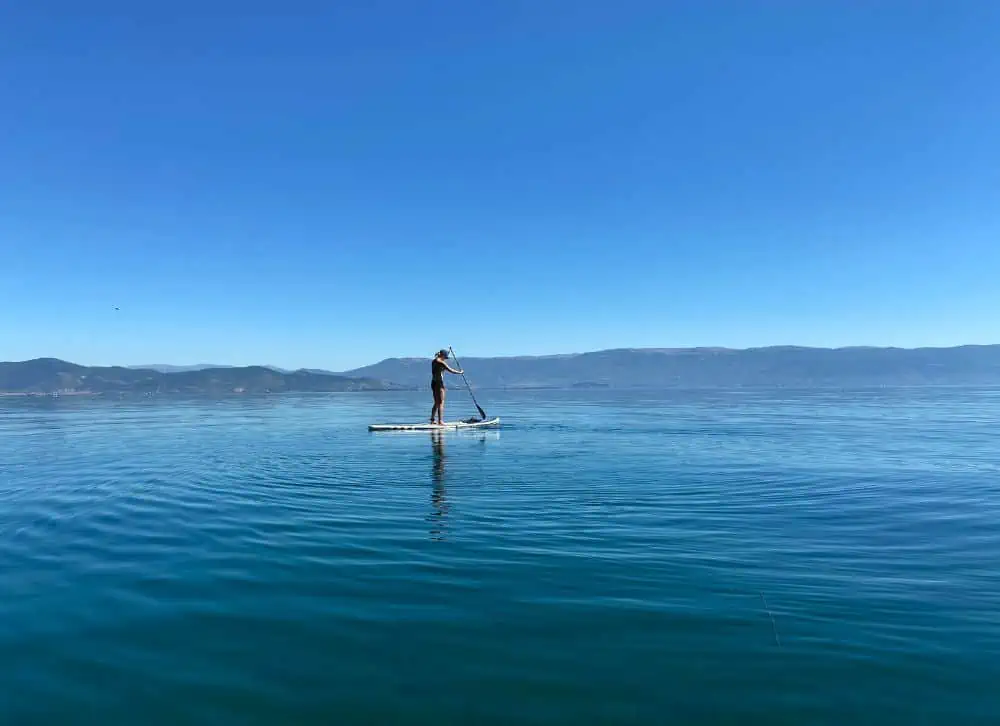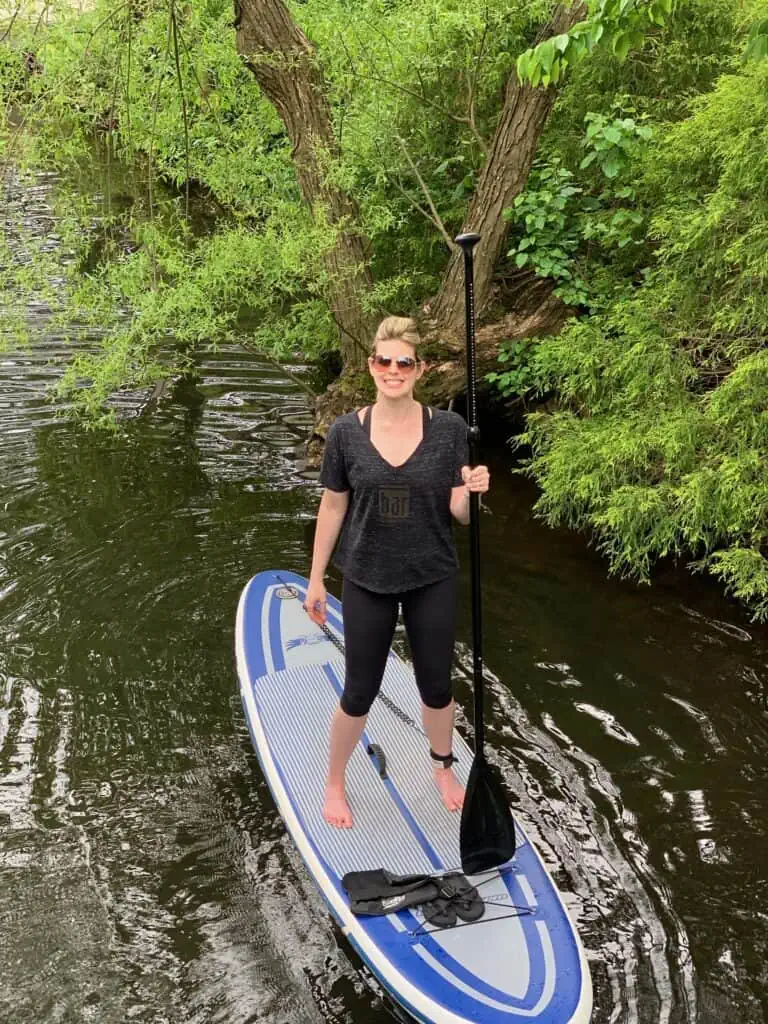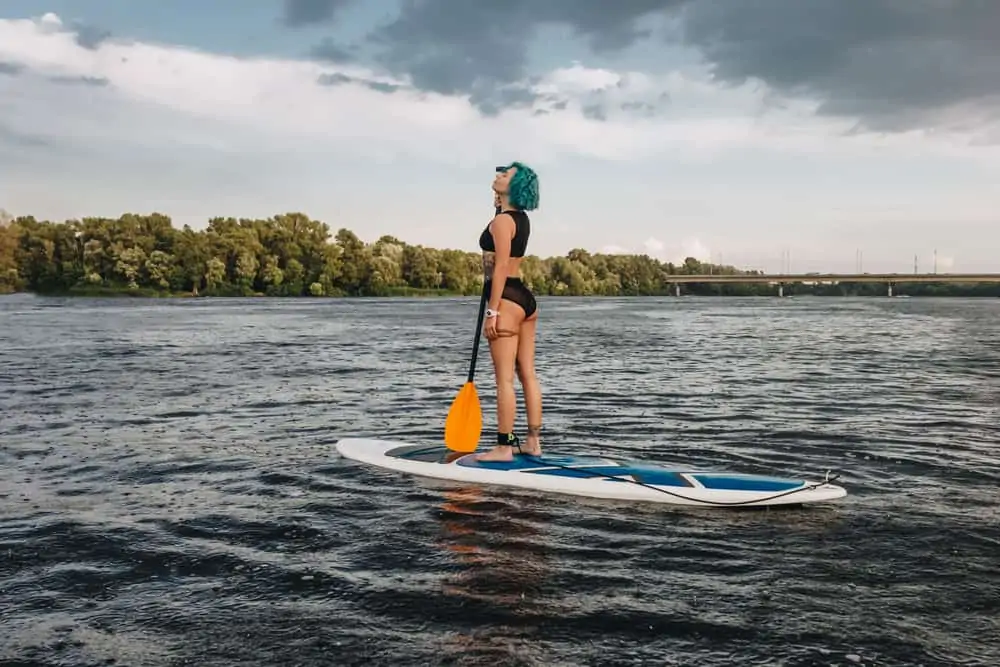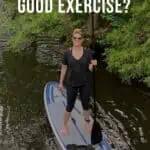This post may contain affiliate links. If you click through a link and make a purchase, I may receive a commission at no additional cost to you. As an Amazon Associate, I earn from qualifying purchases. Read the full disclosure here.
If you’ve been to a body of water in recent years, chances are you’ve seen people paddle boarding.
It seems like the latest craze to hit lakes and oceans, but is paddle boarding good exercise? Yes, paddleboarding is a great low-impact activity to help you meet your movement goals and provide some balance and strengthening for the entire body in the process.
Let’s take a deep dive into the exercise benefits of paddleboarding, plus tips on how you can get started or get better with this fun water activity.
Disclaimer: This content is for educational purposes and is not medical advice. Read the full disclaimer.
What is paddle boarding?
Paddle boarding, also known as stand up paddle boarding or SUP, is a popular water sport activity that involves standing on a board and using a long paddle to propel yourself forward through the water.
While a fair amount of balance and body awareness is required to be proficient in paddle boarding to spend more time on your board than in the water, it’s also possible to paddle from a kneeling or seated position. This is a great option if the water is more turbulent or if you’re just looking to relax. You can also just sit there and float!
Paddleboarding is a great low impact workout, and has been used to add to other activities like yoga or fishing.
On a paddle board, you have a fair amount of space to move around, vs. being locked into a kayak. You’ll also get a great tan from all angles.

What muscles does paddle boarding work?
Paddle boarding manages to target a variety of different muscle groups within one activity for a full body workout.
Paddle boarding is a low impact workout that incorporates the the major muscle groups of the legs to keep you balanced including the calves, quads, hamstrings, and glutes.
Paddle boarding also works your core muscles as you diagonally push the paddle from front to back to propel yourself forward.
As for the upper body, paddle boarding is a great workout for the posterior chain, using the muscles of the back and shoulders as you drag the paddle from front to back.
Paddle boarding can also contribute to cardiovascular health if you’re working hard enough to elevate your heart rate.
In areas with plenty of water, it’s common to see SUP fitness or SUP yoga classes pop up, especially in the summer months.
While paddle boarding incorporates several muscle groups, it’s important to understand the difference between an activity like this vs. actual strength training.
While consistent paddle boarding will give you improvements in balance, coordination, and endurance, it won’t give you that toned look that can only be accomplished through resistance or strength training.
Nonetheless, SUP is still a great exercise and can contribute to healthy movement and overall fitness. (Not everything has to be a HIIT-till-you-drop type of activity.)
Tips for keeping your balance while paddle boarding
Paddle boarding is easier than it looks in relatively calm waters, that is.
Here are some tips to stay on your paddle board and develop a good sense of body awareness.
Though it may not feel like it, we’re constantly shifting ever so slightly when sitting and standing. On solid ground, these shifts are less noticeable, but on a paddle board, they are magnified!
When you first get on a paddle board, you may find it difficult to adjust to these shifts. Keep your feet hip-width apart or slightly wider with a soft bend at the knees and hips. This places you in a good position to detect and react to balance shifts by keeping your leg muscles activated.
Avoid locking your joints and disengaging your muscles.
You can work your way up to standing by practicing paddling in a tall kneeling position. In this position, your center of gravity is closer to the paddle board, and you’ll be able to better control movements. This position will also help develop core strength and a sense of balance while on the board.
If you’re looking to work on your balance for paddle boarding outside of the water, you can get a balance board. A balance board will help you learn how to distribute your weight and center yourself.

Does paddle boarding burn calories?
Most people are not getting the weekly recommended amount of activity to stay healthy. Luckily, paddleboarding can help you reach your activity goals!
Of course, these measurements will vary from person to person depending on a variety of factors like current fitness level and how hard you’re working, but generally, paddle boarding burns an average of 300-430 calories per hour. (But that’s only if you’re standing and continuously paddling. Sitting and floating don’t count!)
For an exact calculation, I recommend wearing a fitness tracker so you know exactly how many calories you burn. In general, the harder you’re working, the more calories you’ll burn.
Related read: How Accurate Is Apple Watch Heart Rate?
Are inflatable paddle boards good?
The first time I tried paddle boarding was in Florida on the beach. It was mid-summer, and both the weather and water temperature were super warm, so I had no issues with falling in.
Other than one initial fall (which resulted in losing a pair of good sunglasses in the ocean), I got the hang of it pretty quickly.
The biggest issue was dragging the giant paddle board down the beach. (After which, I gave up and let my husband carry it back.)
Other than carrying the board, it was super fun! We lived near a lake at the time and wanted to see about paddle boarding more regularly, and my husband found me an inflatable paddle board.
The material is extremely firm and durable; once it’s completely blown up, you’d never know there was air inside.
The inflatable paddle board is much easier to manage and maneuvers fantastic in the water. I’ve had it for over 6 years, and I can manage to carry it myself. It can also be deflated for storage.
There are tons of affordable inflatable paddle boards on Amazon.
Safely tips for paddle boarding
Consider these safety tips before you head out on your paddle board.
Be a strong swimmer
This is pretty obvious, but if you’re not a strong swimmer, then water sports like paddle boarding are probably not for you. Especially in the beginning, there’s a high chance you’ll fall into the water.
Only give paddle boarding a try if you’re confident that you’re a strong enough swimmer, and make sure you are never paddleboarding alone.
Take a life jacket
Even if you’re a strong swimmer, a life jacket is always a good idea, or at least to have one handy while you’re out.
Be cautious with mounting and dismounting your paddle board
Paddle boards can shift quickly as if someone is pulling the rug out from underneath you in a cartoon, and hitting your head on a dock would really ruin the fun.
The safest way to mount and dismount your board is to slide yourself over from a seated position on a stable area to the board. Then push yourself away from the platform or dock to have some extra room around you.
If you’re in the ocean, paddle yourself out until the water is deeper. When you feel comfortable, you can gradually work your way up to standing.
Use the buddy system
Paddle boarding with at least one other person is a good idea to make sure someone can help in the event of an emergency.
If you are paddleboarding alone, Have a phone with you in a waterproof bag. You can strap these down to the paddle board; many models have bungee cords to be able to call for help if needed.
There are also larger waterproof backpacks if you have clothing or other larger items you want to keep dry.
Always use the ankle strap
If you fall, this prevents you from getting separated from your paddle board in the event of any current or wind, etc.
Observe water safety signs and guidelines (weather, wind, currents, water pollution)
Paddle boarding is typically done in lakes and oceans. Always observe weather conditions and ocean current warnings.
For lakes, be aware of the weather and if there are any pollution, bacteria, or animal risks in the water.
Not all bodies of water are safe for paddleboarding, don’t assume a body of water is safe to go in (even if you see other people doing it).
Don’t paddleboard if bad weather is imminent
Another obvious caution, but bad weather can roll in quickly, and you don’t want to be stuck out in the middle of a body of water when this happens.
Always check weather conditions and be observant of quick-moving storm clouds and take necessary precautions.
Use sunscreen
On a paddle board, you get sun from all angles, so be sure to put on sunscreen. If you’re after an amazing tan, paddle boarding is sure to help with that.
Bring water
Especially in hot climates, dehydration can set in fast. You definitely don’t want to be feeling lightheaded while out in the middle of the water with your paddleboard.
Bring plenty of water with you to stay hydrated.
So, is paddle boarding good exercise?
Paddleboarding is a fun activity to help you meet your movement goals and provide some balance and strengthening for the entire body in the process.


